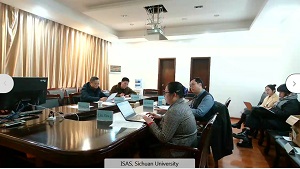On 13 January 2022, VIF held a virtual interaction with scholars from Sichuan University. The speakers were Amb. Anil Wadhwa (retd), Amb Gautam Mukhopadhaya (retd) and Mr. Pranav Kumar from the Indian side. Prof. Liu Siwei, Prof. Zhang Li, Prof. Yang Wenwu were part of the Chinese delegation. The discussion took place on three areas- the Indo-Pacific, Afghanistan and, on respective economies. Both sides exchanged views on these issues. The bilateral relations have changed, the standoff at the LAC continues. Simultaneously the global and regional situation has changed. The Indian side conveyed that the bilateral relations should be improved but unresolved border, disturbances and violation of peace and tranquillity have affected bilateral ties. The Chinese side acknowledged that bilateral relations are in critical times but emphasised on economic potential between the two countries.
Views on the Indo-Pacific
Indian Perspective
The Indo-Pacific addresses the limitations of the Asia-Pacific construct and it is an evolution of the natural process of connection and interdependence between the two oceans. India’s concept of the Indo-Pacific is inclusive, open and ASEAN-centric as outlined by the prime minister during the Shangri-La Dialogue. India has important economic and political interests in the Indo-Pacific, and it would like to see this region well connected; a free-flow of trade and movement, devoid of threats. Therefore, international law, including the UNCLOS is crucial.
India is primarily an Indian Ocean country, with responsibility to safeguard its coastline, EEZ and its resources. The Strait of Hormuz is critical for its energy and trade flows; hence it is an operational area. India’s interests are not limited to the Bay of Bengal but also in the Arabian Sea. The Indo-Pacific is therefore, from Eastern Africa to the Western Pacific. 40 per cent of India’s trade passes through the Malacca; likewise, the Sunda and Lombok Straits are also important pathways. India’s bilateral trade with countries in this region is increasing: in 2020 it was USD 87 billion with ASEAN, USD 87 billion with China, USD 38 billion with Japan and Korea combined, and USD 14 billion with Australia.
India has interests in Southeast Asia, especially Vietnam where EEZ and boundary demarcations should be respected. The Code of Conduct for the South China Sea should be fully consistent with UNCLOS and must safeguard interests of non-negotiating members.
ASEAN will remain central to India. ASEAN has supported India’s active role in managing regional security. India and ASEAN developmental cooperation lies in blue economy, hydrography services, connectivity and oceanography. Indian investment in ASEAN is growing, hence India supports a stable and secure international trade regime.
India’s Indo-Pacific Oceans’ Initiative (IPOI) is in line with the ASEAN Outlook on the Indo-Pacific and UN SDG no.14. The IPOI has seven pillars; and India has invited other countries to join in. SAGAR is India’s goal of building an environment of trust and transparency, of showing sensitivity to each other’s’ interests, respect international maritime laws, peaceful settlement of disputes and, increased maritime cooperation.
Indian regional initiatives are expected to reduce time, cut costs and promote seamless trade integration in our extended neighbourhood.
Common prosperity and security requires common rules-based order through dialogue, it must apply to all countries and to global commons; it should respect sovereignty, territorial integrity, and equality of nations. These rules must be based on consent, universality, on faith and dialogue and not on force and the power of the few. When nations make international commitments, it should be upheld. This is the basis of multilateralism. Connectivity initiative should be based on respect for territoriality, trust, viability, sustainability, it should improve trade and do not put countries into debt or create tension.
Chinese Perspective
The Indo-Pacific is not a new concept though it is now popular, with US, India, Australia, and Japan, with their respective Indo-Pacific strategies. These strategies talk about interconnection between the two oceans, emphasises maritime issues like maritime security and blue economy. The Indo-Pacific has political and economic significance. It is a new framework for strategic analysis and to shape regional order and security. Many Chinese scholars have assessed the Indo-Pacific regional order and its impact on China, especially how the US Indo-Pacific policy influences regional relations and the way it affects China’s security.
China does not have an Indo-Pacific policy but this region is part of the Chinese foreign policy. China and ASEAN recognise the importance of interconnectivity of the two oceans, just as there are more interactions and more actors in this region. China is active in this region and according to the Chinese view, China’s economic and security initiatives are ‘public goods.’
China has numerous concerns in the Indo-Pacific:
- US-led multilateral security networks like the AUKUS and Quad are exclusive. Chinese perspective desires these networks to be more open and multilateral.
- AUKUS will potentially destroy regional stability and lead to nuclear proliferation.
- Indo-Pacific region is dynamic where different countries have different ideas and interests, so coordinating such variation is important.
- The US and Australia are security-focussed hence they over-securitise issues like energy and development. This is problematic and leads to distrust. Hence as big countries, India and China need to have more dialogues.
Currently, India-China bilateral relations are problematic and complicated but in other areas such as maritime domain, both sides should conduct more dialogues.
Overview of Chinese and Indian Economies
Chinese Perspective
China’s macroeconomic growth is on a downward trend affected by Covid-19 in 2021-2022. China successfully controlled the Covid-19 in 2020-21 and managed the negative impact on its economy. The Chinese economy's Consumer Price Index (CPI) during the beginning of Covid-19 was at five per cent with limited production and supply of raw materials. The CPI is increasing with rising prices of commodities and global energy prices. Employment in China is stable and improving, and achieved the goal of employment generation.
Growth rates have declined. The budget expenditure fluctuates, is lesser than income, and the policy is tightened to handle economic shifts. Chinese government stimulated the economy by increasing money supply. Credit Expansion is faster than cash circulation which reflects the trade-off in the economy. Another problem is that the newly-infused liquidity is not floating through the real economy. As a compounding result, the real economic recovery of China is sluggish.
Other problems in the Chinese economy are operational uncertainties of in Covid-19 conditions. The overall situation of Covid-19 in the world are not conducive for China’s economic recovery; continuous stress on supply of raw materials and shortage of intermediate products and critical components like chips has intensified, saturated the logistics and distribution capacities in global trade. Local governments in China are under tremendous pressure to repay principal and interests for their debts. The bad debt of some Chinese banks is a concern in the future.
In order to manage the economy in these circumstances, it is advised to implement loose monetary policy to inject liquidity into the market with policy tools like deposit reserve. These policy tools help to maintain stable economic growth and generate employment. The control of the scale of debts of some local governments and some companies by government and optimize the income distribution structure in China.
Indian Perspective
The last two years were challenging for the Indian economy, particularly in 2020 when the growth was negative. India's real GDP is expected to grow at 9.2 per cent in 2021-22. The domestic demand has not returned to the normal levels and the Indian industry has returned to 90-95 per cent of production levels. However, the measures announced by the Indian government, like stimulus and many policy reform initiatives, have helped recovery. Yet, Covid-19 is still disrupting the Indian economy.
India is trying to graduate to high-value/ hi-tech manufacturing through several reforms and incentives focussed on electronics manufacturing. Economic indicators like inflation and interest rates are very healthy helping to attract global investment. India is on the track of achieving the target of exports worth USD 400 billions of goods in this financial year. The main challenge is to sustain the exports growth and integrate it into the global value chain.
Views on Afghanistan
Indian Perspective
Afghanistan remains in state of flux under the Taliban regime. The Doha Peace Process was conducted on false assumptions that the Taliban has changed and that they will ensure inclusive government. These hopes have been shattered as the Taliban 2.0 is perhaps more radicalized and dangerous than its previous version. The Taliban regime has failed to provide stability to Afghanistan. In fact, there has been an uptick in terror attacks and Jihadist extremism is on the rise.
As far as India is concerned, it is following a three-track strategy vis-à-vis Taliban. First, is to control the spill-over of terrorism and radicalisation since it impinges on India’s security. India is concerned about the fallout of the situation in Afghanistan on its internal security. Second, is to provide humanitarian assistance to Afghanistan under which India has provided 50,00 tonnes of wheat, three consignments of medicines and one million doses of covid-19 vaccines. Third, is to have a minimal and formal contact with Taliban since India has heavily invested in peace and development in Afghanistan. India’s interest is in a stable Afghanistan, and this is where its position is divergent from that of Pakistan. Pakistan wants to either keep Afghanistan under its political tutelage or keep it de-stabilised.
Chinese Perspective
China is worried about instability in Afghanistan. China is also concerned over Taliban’s promises of an inclusive government. Further, China thinks that there is a possibility of regime change in Afghanistan, therefore, it is following a nuanced engagement. While China has these concerns it is however, providing humanitarian and economic assistance to Afghanistan. China has supplied medicines, covid-19 vaccines and winter supplies.
China’s biggest concern in Afghanistan is the impact it is likely to have on stability in Xinjiang. A spill-over from warring factions or terrorists from Afghanistan into Xinjiang is a matter of grave concern. As far as the spill-over from Afghanistan into their respective border regions is concerned, China and India have converging security interests.
China’s preferred strategy for Afghanistan would be to adopt a regional approach; hence it would like to see an active SCO for discussions related to Afghanistan.
After the respective presentations there was an interactive session to clarify and discuss the related aspects. The exchanges were mutually beneficial.





Post new comment